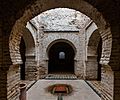Alcázar of Jerez de la Frontera facts for kids
Quick facts for kids Alcázar of Jerez de la Frontera |
|
|---|---|
| Native name Spanish: Alcázar de Jerez de la Frontera |
|
 |
|
| Location | Jerez de la Frontera, Spain |
| Architectural style(s) | Almohad, Baroque |
| Official name: Alcázar de Jerez de la Frontera | |
| Type | Non-movable |
| Criteria | Monument |
| Designated | 1931 |
| Reference no. | RI-51-0000494 |
| Lua error in Module:Location_map at line 420: attempt to index field 'wikibase' (a nil value). | |
The Alcázar of Jerez de la Frontera is an old fortress in Jerez de la Frontera, a city in southern Spain. It was built by the Moors, who were Muslim people from North Africa. Today, it is a beautiful park and a historical site.
This amazing place was officially recognized as a "Cultural Interest Asset" in 1931. This means it's a very important historical monument in Spain.
The first fortress was likely built in the 11th century. At that time, Jerez was part of a small kingdom called the Taifa of Arcos. The site itself has been used by people since ancient times.
In the 12th century, a new, stronger structure was built. It served as both a home and a fort for the Almohad Caliphate. This was a powerful Muslim empire.
Later, after the Christian armies took back Spain in the Reconquista, the Alcázar became home to the first Christian leaders. More buildings were added, including a palace. The Alcázar is a great example of Almohad architecture in Spain.
Contents
Exploring the Alcázar
The Alcázar is surrounded by strong walls that form a rough square shape. These walls are about 4,000 meters long. Inside, you can see different styles of buildings.
For example, the Octagonal Tower was built in the Almohad style. This style is known for its simple yet strong designs. The Palace of Villavicencio, built much later in 1664, shows off the fancy Baroque style.
The Alcázar Mosque
One special building inside the Alcázar is a mosque. It's the only one left from the 18 mosques that used to be in the city. After Christian forces took over the fortress in 1261, this mosque was changed.
King Alfonso X of Castile turned it into a church dedicated to the Virgin Mary. The tall tower, which was once the minaret, became a bell tower. Inside the prayer hall, you can still see the mihrab. This is a special niche that shows the direction of Mecca, where Muslims pray.
Other Key Buildings
- Palace of Doña Blanca: This part dates back to the 12th-century Islamic structure. It was originally a beautiful pavilion used for relaxation.
- The Bathhouse (Hammam): This old bathhouse has several rooms. There's an entrance area where people would get ready. Then, there are cold and warm rooms, with the warm room being the largest. The final room was the hot room, and you can still see parts of its heating system.
How the Alcázar Was Defended
The Alcázar had a very clever defense system. It had two walls! An outer wall, about 4 meters high, was located 4 meters away from the inner wall. The outer wall had battlements, which are the notched tops you see on castle walls.
The inner wall had towers placed at regular distances. Only 7 of the original towers are still standing today. These towers were mostly built using packed earth and bricks. Some parts even used stones from other old sites.
These towers are called Albarrana Towers. They are special because they are not built directly into the main wall. Instead, they are connected to the wall by a short archway. This design made them harder for attackers to capture.
A City Within a City
The Alcázar was like a small, fortified city inside the larger city of Jerez. This was a common way for the Almohads to build. It meant that everything needed for both military defense and daily life was kept inside its walls.
This included homes, baths, and mosques. There were also places to store supplies and tanks for water. Building such a large complex showed how skilled the Almohads were at construction. They also used fewer decorations than earlier builders, focusing on strong, practical designs.
Gallery
See also
 In Spanish: Alcázar de Jerez de la Frontera para niños
In Spanish: Alcázar de Jerez de la Frontera para niños














